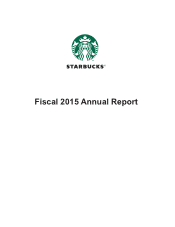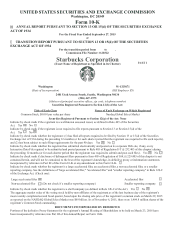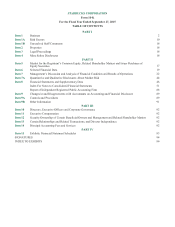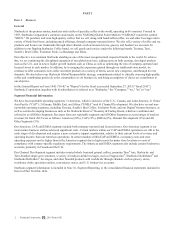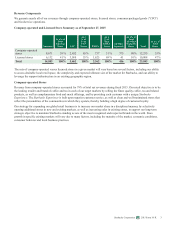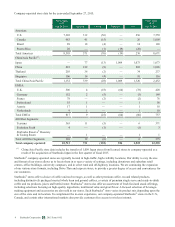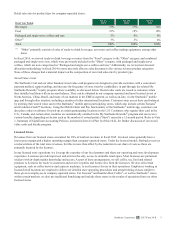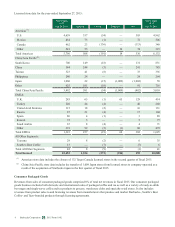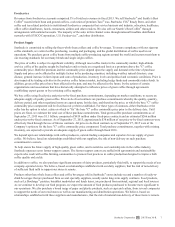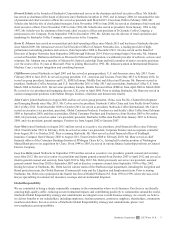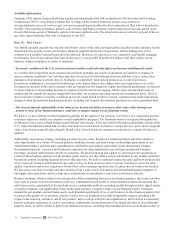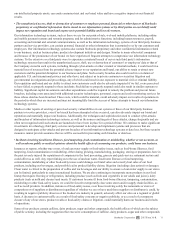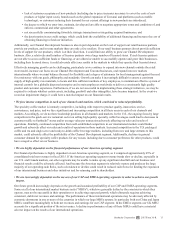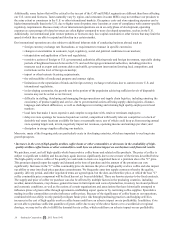Starbucks 2015 Annual Report Download - page 9
Download and view the complete annual report
Please find page 9 of the 2015 Starbucks annual report below. You can navigate through the pages in the report by either clicking on the pages listed below, or by using the keyword search tool below to find specific information within the annual report.
Retail sales mix by product type for company-operated stores:
Fiscal Year Ended
Sep 27,
2015
Sep 28,
2014
Sep 29,
2013
Beverages 73% 73% 74%
Food 19% 18% 18%
Packaged and single-serve coffees and teas 3% 4% 4%
Other(1) 5% 5% 4%
Total 100% 100% 100%
(1) "Other" primarily consists of sales of ready-to-drink beverages, serveware and coffee-making equipment, among other
items.
In fiscal 2014, we moved ready-to-drink beverage revenues from the "Food" category to the "Other" category and combined
packaged and single-serve teas, which were previously included in the "Other" category, with packaged and single-serve
coffees, which are now categorized as "Packaged and single-serve coffees and teas." Additionally, we revised our discount
allocation methodology in fiscal 2014 to more precisely allocate sales discounts to the various revenue product categories.
None of these changes had a material impact on the composition of our retail sales mix by product type.
Stored Value Cards
The Starbucks Card and our other branded stored value card programs are designed to provide customers with a convenient
payment method, support gifting, and increase the frequency of store visits by cardholders, in part through the related My
Starbucks Rewards® loyalty program where available, as discussed below. Stored value cards are issued to customers when
they initially load them with an account balance. They can be obtained in our company-operated and most licensed stores in
North America, China, Brazil, and many of our markets in the EMEA segment, as well as on-line, via the Starbucks® mobile
app, and through other retailers, including a number of other international locations. Customers may access their card balances
by utilizing their stored value card or the Starbucks® mobile app in participating stores, which also include certain Teavana®
and Evolution Fresh™ locations. Using the Mobile Order and Pay functionality of the Starbucks® mobile app, customers can
also place orders in advance for pick-up at certain participating locations in the U.S. Customers who register their card in the
U.S., Canada, and certain other countries are automatically enrolled in the My Starbucks Rewards® program and can receive
various benefits depending on factors such as the number of reward points ("Stars") earned in a 12-month period. Refer to Note
1, Summary of Significant Accounting Policies, included in Item 8 of Part II of this 10-K, for further discussion of our stored
value cards and loyalty program.
Licensed Stores
Revenues from our licensed stores accounted for 10% of total net revenues in fiscal 2015. Licensed stores generally have a
lower gross margin and a higher operating margin than company-operated stores. Under the licensed model, Starbucks receives
a reduced share of the total store revenues, but this is more than offset by the reduction in our share of costs as these are
primarily incurred by the licensee.
In our licensed store operations, we leverage the expertise of our local partners and share our operating and store development
experience. Licensees provide improved, and at times the only, access to desirable retail space. Most licensees are prominent
retailers with in-depth market knowledge and access. As part of these arrangements, we sell coffee, tea, food and related
products to licensees for resale to customers and receive royalties and license fees from the licensees. We also sell certain
equipment, such as coffee brewers and espresso machines, to our licensees for use in their operations. Employees working in
licensed retail locations are required to follow our detailed store operating procedures and attend training classes similar to
those given to employees in company-operated stores. For Teavana® and Seattle's Best Coffee®, as well as Starbucks® stores
within certain markets, we also use traditional franchising and include these stores in the results of operations from our other
licensed stores.
Starbucks Corporation 2015 Form 10-K 5

